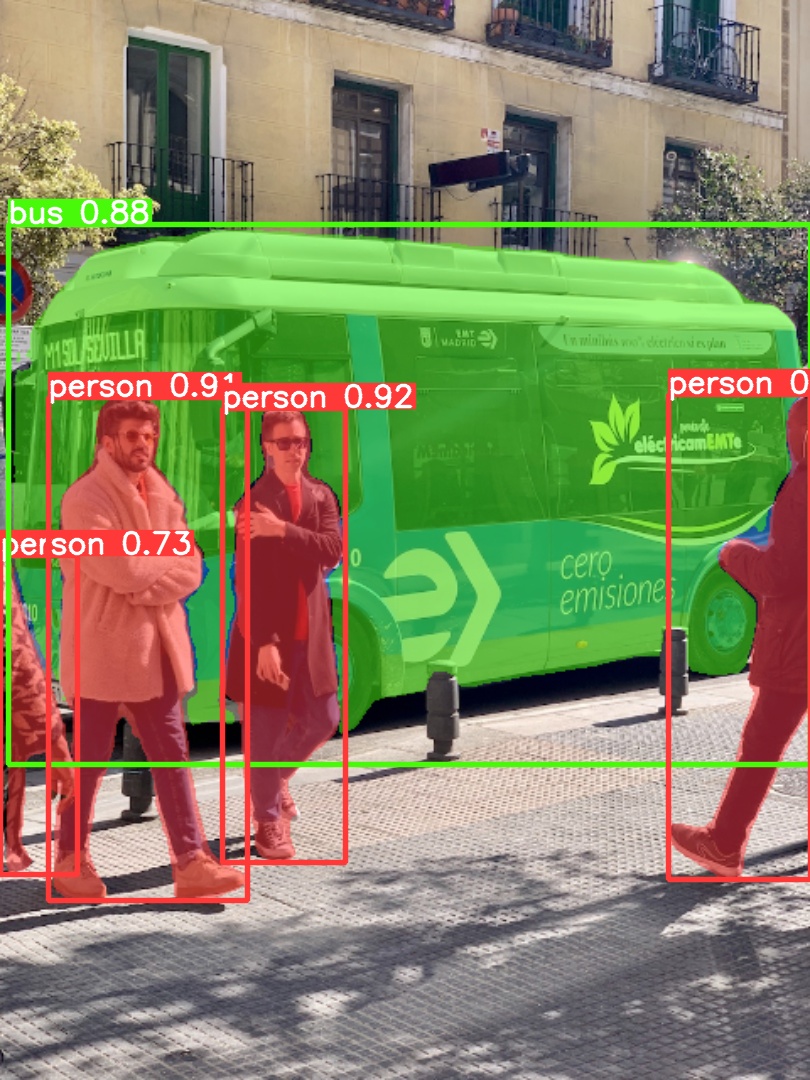Describe the bug
A clear and concise description of what the bug is.
Environment
Environment you use when bug appears:
- Python version: 3.8
- PyTorch Version: 2.0.0+cu118
- MMCV Version: 2.0.1
- EdgeLab Version
- Code you run:
python tools/train.py configs/fomo/fomo_person.py --cfg-options \work_dir=work_dirs/fomo_300 num_classes=1 epochs=300 height=416 width=416 data_root=datasets/coco_person/
- The detailed error
Traceback (most recent call last):
File "tools/train.py", line 226, in
main()
File "tools/train.py", line 221, in main
runner.train()
File "/home/ubuntu/.local/lib/python3.8/site-packages/mmengine/runner/runner.py", line 1777, in train
model = self.train_loop.run() # type: ignore
File "/home/ubuntu/.local/lib/python3.8/site-packages/mmengine/runner/loops.py", line 96, in run
self.run_epoch()
File "/home/ubuntu/.local/lib/python3.8/site-packages/mmengine/runner/loops.py", line 112, in run_epoch
self.run_iter(idx, data_batch)
File "/home/ubuntu/.local/lib/python3.8/site-packages/mmengine/runner/loops.py", line 128, in run_iter
outputs = self.runner.model.train_step(
File "/home/ubuntu/Documents/ModelAssistant/sscma/models/detectors/fomo.py", line 99, in train_step
losses = self._run_forward(data, mode='loss') # type: ignore
File "/home/ubuntu/.local/lib/python3.8/site-packages/mmengine/model/base_model/base_model.py", line 361, in _run_forward
results = self(**data, mode=mode)
File "/home/ubuntu/.local/lib/python3.8/site-packages/torch/nn/modules/module.py", line 1501, in _call_impl
return forward_call(*args, **kwargs)
File "/home/ubuntu/Documents/ModelAssistant/sscma/models/detectors/fomo.py", line 70, in forward
return self.loss(inputs, data_samples)
File "/home/ubuntu/.local/lib/python3.8/site-packages/mmdet/models/detectors/single_stage.py", line 78, in loss
losses = self.bbox_head.loss(x, batch_data_samples)
File "/home/ubuntu/Documents/ModelAssistant/sscma/models/heads/fomo_head.py", line 115, in loss
loss = self.loss_by_feat(pred, batch_gt_instances, batch_img_metas, batch_gt_instances_ignore)
File "/home/ubuntu/Documents/ModelAssistant/sscma/models/heads/fomo_head.py", line 150, in loss_by_feat
loss, cls_loss, bg_loss, P, R, F1 = multi_apply(self.lossFunction, preds, target)
File "/home/ubuntu/.local/lib/python3.8/site-packages/mmdet/models/utils/misc.py", line 219, in multi_apply
return tuple(map(list, zip(*map_results)))
File "/home/ubuntu/Documents/ModelAssistant/sscma/models/heads/fomo_head.py", line 188, in lossFunction
P, R, F1 = self.get_pricsion_recall_f1(preds, data)
File "/home/ubuntu/Documents/ModelAssistant/sscma/models/heads/fomo_head.py", line 229, in get_pricsion_recall_f1
site = np.sum([ti, po], axis=0)
File "<array_function internals>", line 200, in sum
File "/home/ubuntu/anaconda3/envs/model2/lib/python3.8/site-packages/numpy/core/fromnumeric.py", line 2324, in sum
return _wrapreduction(a, np.add, 'sum', axis, dtype, out, keepdims=keepdims,
File "/home/ubuntu/anaconda3/envs/model2/lib/python3.8/site-packages/numpy/core/fromnumeric.py", line 86, in _wrapreduction
return ufunc.reduce(obj, axis, dtype, out, **passkwargs)
ValueError: setting an array element with a sequence. The requested array has an inhomogeneous shape after 1 dimensions. The detected shape was (2,) + inhomogeneous part.
Additional context
I'm using latest version of ModelAssistant .
after I change site = np.sum([ti, po], axis=0)in ModelAssistant/sscma/models/heads/fomo_head.pywith site = np.concatenate([ti, po], axis=0) it stat training,but I get another error when training the model
Traceback (most recent call last):
File "tools/train.py", line 226, in
main()
File "tools/train.py", line 221, in main
runner.train()
File "/home/ubuntu/.local/lib/python3.8/site-packages/mmengine/runner/runner.py", line 1777, in train
model = self.train_loop.run() # type: ignore
File "/home/ubuntu/.local/lib/python3.8/site-packages/mmengine/runner/loops.py", line 102, in run
self.runner.val_loop.run()
File "/home/ubuntu/.local/lib/python3.8/site-packages/mmengine/runner/loops.py", line 371, in run
self.run_iter(idx, data_batch)
File "/home/ubuntu/.local/lib/python3.8/site-packages/torch/utils/_contextlib.py", line 115, in decorate_context
return func(*args, **kwargs)
File "/home/ubuntu/.local/lib/python3.8/site-packages/mmengine/runner/loops.py", line 392, in run_iter
self.evaluator.process(data_samples=outputs, data_batch=data_batch)
File "/home/ubuntu/.local/lib/python3.8/site-packages/mmengine/evaluator/evaluator.py", line 60, in process
metric.process(data_batch, _data_samples)
File "/home/ubuntu/Documents/ModelAssistant/sscma/evaluation/fomo_metric.py", line 74, in process
tp, fp, fn = multi_apply(self.compute_ftp, preds, target)
File "/home/ubuntu/.local/lib/python3.8/site-packages/mmdet/models/utils/misc.py", line 219, in multi_apply
return tuple(map(list, zip(*map_results)))
File "/home/ubuntu/Documents/ModelAssistant/sscma/evaluation/fomo_metric.py", line 48, in compute_ftp
confusion = confusion_matrix(
File "/home/ubuntu/.local/lib/python3.8/site-packages/sklearn/utils/_param_validation.py", line 214, in wrapper
return func(*args, **kwargs)
File "/home/ubuntu/.local/lib/python3.8/site-packages/sklearn/metrics/_classification.py", line 326, in confusion_matrix
y_type, y_true, y_pred = _check_targets(y_true, y_pred)
File "/home/ubuntu/.local/lib/python3.8/site-packages/sklearn/metrics/_classification.py", line 84, in _check_targets
check_consistent_length(y_true, y_pred)
File "/home/ubuntu/.local/lib/python3.8/site-packages/sklearn/utils/validation.py", line 407, in check_consistent_length
raise ValueError(
ValueError: Found input variables with inconsistent numbers of samples: [144, 24]
Additional context
if i set tp = fp = fn = 0 ,it works. but when I convert the model to binary and deploy it on the ESP32-S3 Eye, I encounter the following errors:
When I convert the model to binary and deploy it on the ESP32-S3 Eye, I encounter the following errors:
Didn't find op for builtin opcode 'TRANSPOSE'
Failed to get registration from op code TRANSPOSE
AllocateTensors() failed
and
W (4927) cam_hal: Failed to get the frame on time!
ERROR A stack overflow in task app_camera has been detected.
Backtrace: 0x40375b5e:0x3fca8680 0x4037cc1d:0x3fca86a0 0x4037f64a:0x3fca86c0 0x4037e2bf:0x3fca8740 0x4037f758:0x3fca8760 0x4037f74e:0xa5a5a5a5 |<-CORRUPTED
0x40375b5e: panic_abort at /home/ubuntu/esp/v5.1.2/esp-idf/components/esp_system/panic.c:452
0x4037cc1d: esp_system_abort at /home/ubuntu/esp/v5.1.2/esp-idf/components/esp_system/port/esp_system_chip.c:84
0x4037f64a: vApplicationStackOverflowHook at /home/ubuntu/esp/v5.1.2/esp-idf/components/freertos/FreeRTOS-Kernel/portable/xtensa/port.c:581
0x4037e2bf: vTaskSwitchContext at /home/ubuntu/esp/v5.1.2/esp-idf/components/freertos/FreeRTOS-Kernel/tasks.c:3729
0x4037f758: _frxt_dispatch at /home/ubuntu/esp/v5.1.2/esp-idf/components/freertos/FreeRTOS-Kernel/portable/xtensa/portasm.S:450
0x4037f74e: _frxt_int_exit at /home/ubuntu/esp/v5.1.2/esp-idf/components/freertos/FreeRTOS-Kernel/portable/xtensa/portasm.S:245






